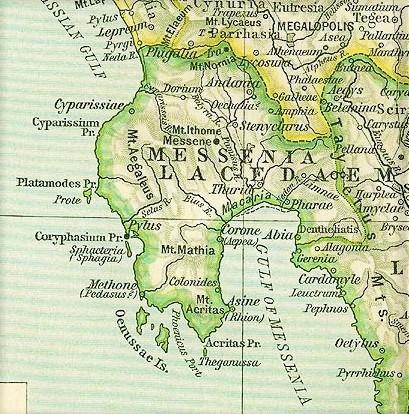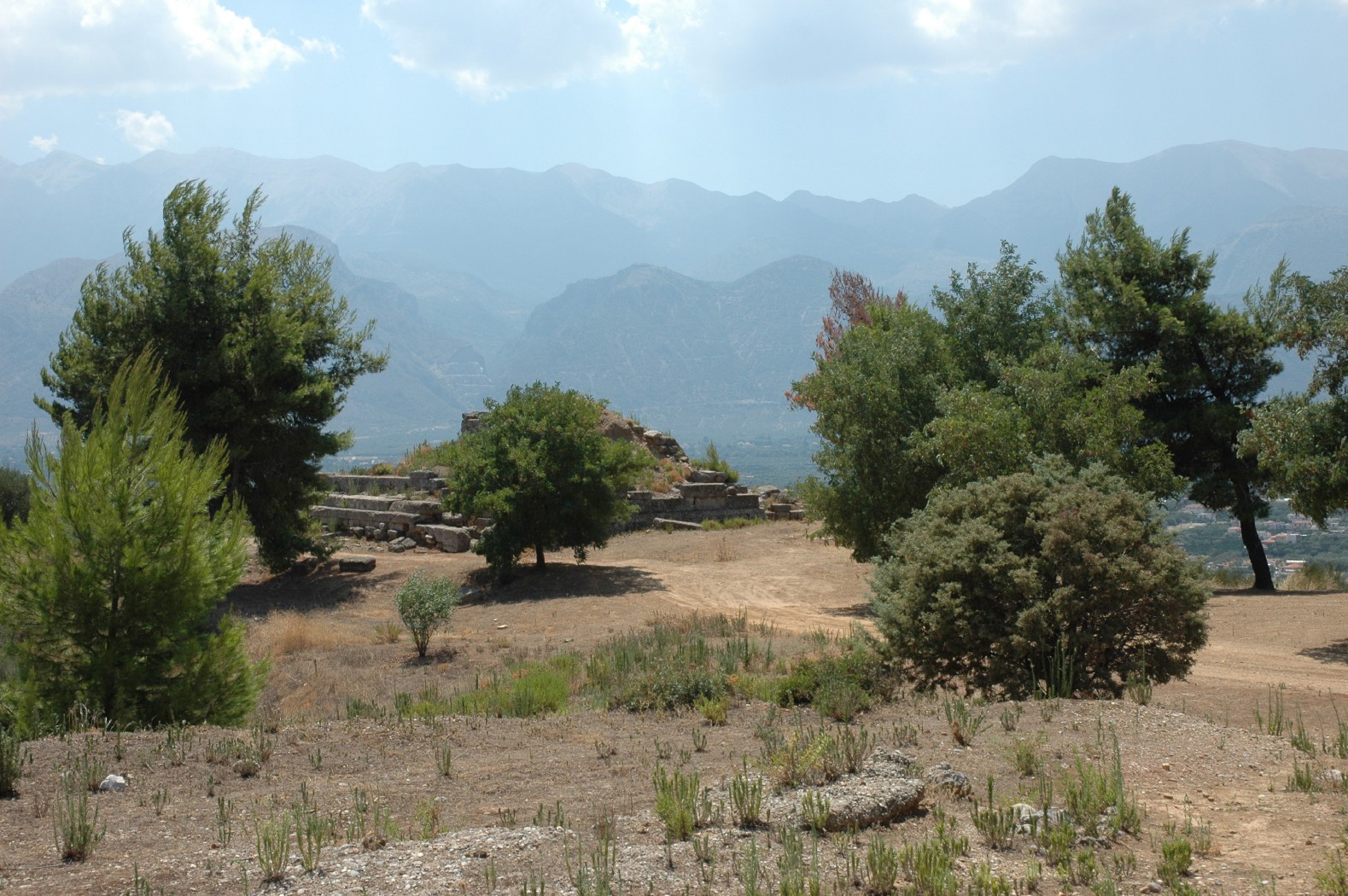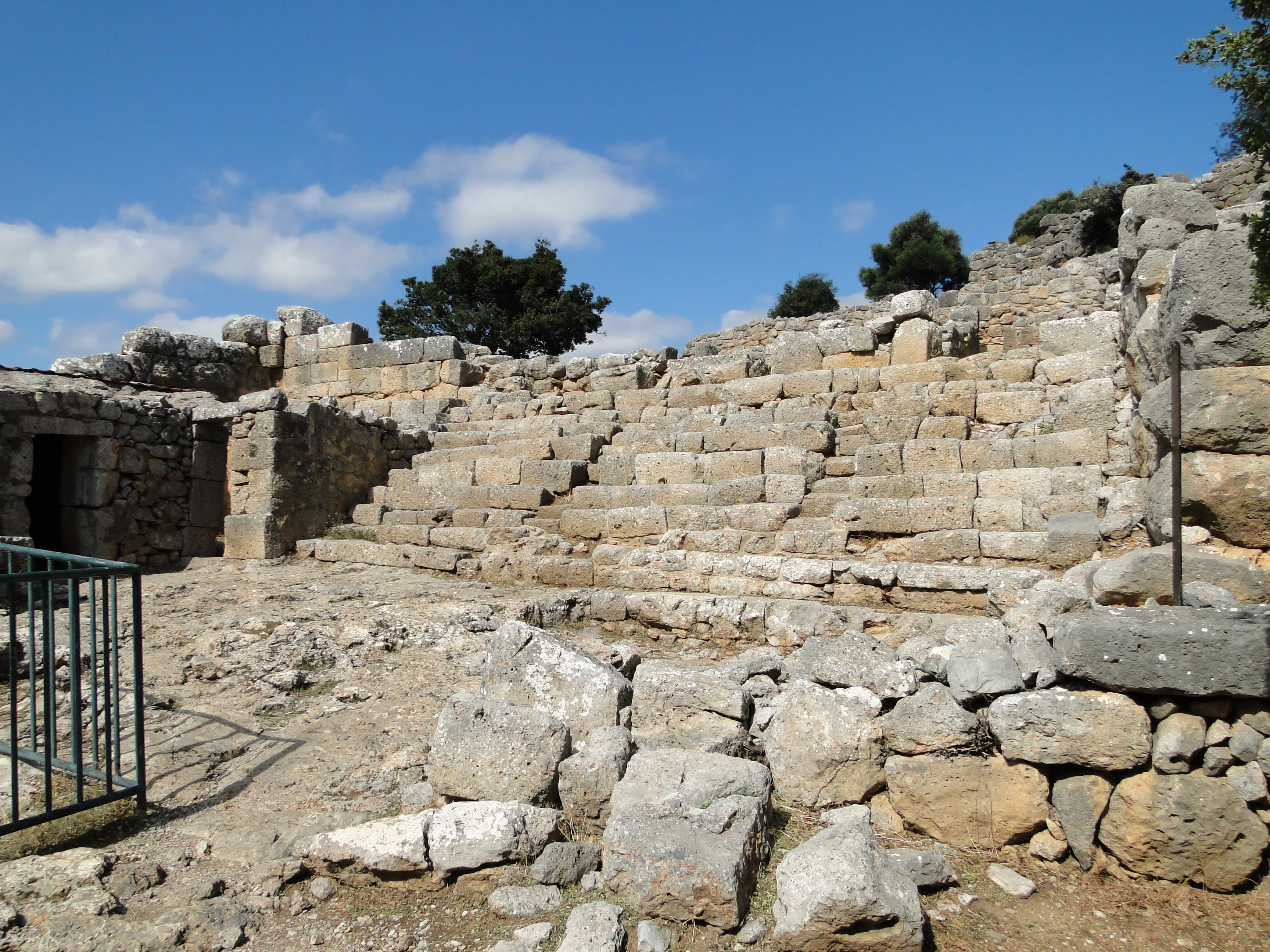|
Ancient Messenia
Messenia () was an ancient district of the southwestern Peloponnese, more or less overlapping the modern Messenia region of Greece. To the north it had a border with Elis along the Neda river. From there the border with Arcadia ran along the tops of Mount Elaeum and Mount Nomia and then through foothills of Taygetus. The eastern border with Laconia went along the Taygetus ridge up to the Koskaraka river, and then along that river to the sea, near the city of Abia. Ancient Messenia descended continuously without change of name and with little change of territory to the modern Regional Unit of Greece of the same name. History Bronze age The earliest inhabitants of Messenia were thought by the Greeks of the Classical period to have been ' Pelasgians', as in other regions of Greece. Supposedly, the Hellenic tribes had then arrived in Greece, and Messenia was settled by Aeolian Greeks. The Mycenaean city of Pylos has been identified with the modern site of Ano Englianos, in wes ... [...More Info...] [...Related Items...] OR: [Wikipedia] [Google] [Baidu] |
Ancient Greece
Ancient Greece () was a northeastern Mediterranean civilization, existing from the Greek Dark Ages of the 12th–9th centuries BC to the end of classical antiquity (), that comprised a loose collection of culturally and linguistically related city-states and communities. Prior to the Roman period, most of these regions were officially unified only once under the Kingdom of Macedon from 338 to 323 BC. In Western history, the era of classical antiquity was immediately followed by the Early Middle Ages and the Byzantine period. Three centuries after the decline of Mycenaean Greece during the Bronze Age collapse, Greek urban poleis began to form in the 8th century BC, ushering in the Archaic period and the colonization of the Mediterranean Basin. This was followed by the age of Classical Greece, from the Greco-Persian Wars to the death of Alexander the Great in 323 BC, and which included the Golden Age of Athens and the Peloponnesian War. The u ... [...More Info...] [...Related Items...] OR: [Wikipedia] [Google] [Baidu] |
Nichoria
Nichoria () is a site in Messenia, on a ridgetop near modern Rizomylos, at the northwestern corner of the Messenian Gulf. From the Middle to Late Bronze Age it cultivated olive and terebinth for export.Palaima (2000), p. 17. During the Helladic period it was part of the Mycenaean civilisation. Nichoria reached its greatest extent (5 hectares) in LHIIIA:2, and even sported a royal Pylos-style megaron; although it was always smaller. Nichoria became subordinate to Pylos and lost the use of its megaron.Davis and Alcock (1998), pp. 127-128. Toward the end of LH IIIB, the palace at Pylos knew Nichoria under the name of TI-MI-TO A-KO.Shelmerdine (1981). Nichoria was a major outpost of Pylos's "Trans-Aigolaia" province. According to Palaima, "it occurs on ten tablets that relate to: bronze working, six standard items of regional taxation, bronze recycling for weaponry production, coastal defensive arrangements, gold, landholdings, livestock, male personnel, and rather intensive levels ... [...More Info...] [...Related Items...] OR: [Wikipedia] [Google] [Baidu] |
Aristodemus Of Messenia
Aristodemus () was a man of ancient Messenia, who was one of the chief Messenian heroes in the First Messenian War. In the sixth year of that war the Messenians consulted the oracle at Delphi known as the Pythia, and the ambassador Tisis brought back the answer that the preservation of the Messenian state demanded that a virgin girl of the house of the Aepytids should be sacrificed to the gods of the lower world. When the daughter of Lyciscus was drawn by lot, the seer Epebolus declared that she was a stand-in, and not actually a daughter of Lyciscus. Hereupon Lyciscus left his country and went over to the Sparta Sparta was a prominent city-state in Laconia in ancient Greece. In antiquity, the city-state was known as Lacedaemon (), while the name Sparta referred to its main settlement in the Evrotas Valley, valley of Evrotas (river), Evrotas rive ...ns. As, however, the oracle had added, that if, for some reason, the maiden chosen by lot could not be sacrificed, anoth ... [...More Info...] [...Related Items...] OR: [Wikipedia] [Google] [Baidu] |
Teleclus
Teleclus or Teleklos (Greek: Τήλεκλος) was the 8th Agiad dynasty king of Sparta during the eighth century BC. He was the son of King Archelaus and grandson of King Agesilaus I. Pausanias reports that Teleclus' reign saw the conquest of Amyclae, Pharis and Geranthrae, towns of the Perioeci or "dwellers round about". Teleclus was killed during a skirmish with the Messanians during a festival at the temple of Artemis Limnatis, Pausanias 1918 Book 4, IV, 1-3. an event foreshadowing the First Messenian War The First Messenian War was a war between Messenia_(ancient_region), Messenia and Sparta. It began in 743 BC and ended in 724 BC, according to the dates given by Pausanias (geographer), Pausanias. The war continued the rivalry between the Achae .... He was succeeded by his son Alcmenes. Notes References * 8th-century BC monarchs 8th-century BC Spartans Agiad kings of Sparta Ancient Greeks killed in battle 8th-century BC deaths Year of birth unkno ... [...More Info...] [...Related Items...] OR: [Wikipedia] [Google] [Baidu] |
First Messenian War
The First Messenian War was a war between Messenia_(ancient_region), Messenia and Sparta. It began in 743 BC and ended in 724 BC, according to the dates given by Pausanias (geographer), Pausanias. The war continued the rivalry between the Achaeans (tribe), Achaeans and the Dorians that had been initiated by the purported Return of the Heracleidae. Both sides utilized an explosive incident to settle the rivalry by full-scale war. The war was prolonged into 20 years. The result was a Spartan victory. Messenia was depopulated by emigration of the Achaeans to other states. Those who did not emigrate were reduced socially to helots, or serfs. Their descendants were held in hereditary servitude for centuries, until the collapse of the Spartan state in 370 BC. Dates Pausanias' standard dates Pausanias (geographer), Pausanias says that the opening campaign was a surprise attack on Ampheia by a Spartan force commanded by Alcmenes, List of kings of Sparta#Agiad dynasty, Agiad king of Spa ... [...More Info...] [...Related Items...] OR: [Wikipedia] [Google] [Baidu] |
Sparta
Sparta was a prominent city-state in Laconia in ancient Greece. In antiquity, the city-state was known as Lacedaemon (), while the name Sparta referred to its main settlement in the Evrotas Valley, valley of Evrotas (river), Evrotas river in Laconia, in southeastern Peloponnese. Around 650 BC, it rose to become the dominant military land-power in ancient Greece. Sparta was recognized as the leading force of the unified Greek military during the Greco-Persian Wars, in rivalry with the rising naval power of Classical Athens, Athens. Sparta was the principal enemy of History of Athens, Athens during the Peloponnesian War (431–404 BC), from which it emerged victorious after the Battle of Aegospotami. The decisive Battle of Leuctra against Thebes, Greece, Thebes in 371 BC ended the Spartan hegemony, although the city-state maintained its Independence, political independence until its forced integration into the Achaean League in 192 BC. The city nevertheless recovered m ... [...More Info...] [...Related Items...] OR: [Wikipedia] [Google] [Baidu] |
Stenyclarus
Stenyclarus or Stenyklaros (), or Stenyclerus or Stenykleros (Στενύκληρος), was a town in the north of ancient Messenia, and the capital of the Dorian conquerors, built by Cresphontes In Greek mythology, Cresphontes (; ) was a son of Aristomachus, husband of Merope, father of Aepytus and brother of Temenus and Aristodemus. He was a great-great-grandson of Heracles and helped lead the fifth and final attack on Mycenae in t .... Andania had been the ancient capital of the country. The town afterwards ceased to exist, but its name was given to the northern of the two Messenian plains and site of a battle where Messenians defeated a small Spartan army. References Populated places in ancient Messenia Former populated places in Greece Lost ancient cities and towns {{AncientMessenia-geo-stub ... [...More Info...] [...Related Items...] OR: [Wikipedia] [Google] [Baidu] |
Cresphontes
In Greek mythology, Cresphontes (; ) was a son of Aristomachus, husband of Merope, father of Aepytus and brother of Temenus and Aristodemus. He was a great-great-grandson of Heracles and helped lead the fifth and final attack on Mycenae in the Peloponnesus. He became king of Messene. Cresphontes and his brothers complained to the oracle that its instructions had proved fatal to those who had followed them (the oracle had told Hyllus to attack through the narrow passage when the third fruit was ripe). They received the answer that by the "third fruit" the "third generation" was meant, and that the "narrow passage" was not the isthmus of Corinth, but the straits of Rhium. They accordingly built a fleet at Naupactus, but before they set sail, Aristodemus was struck by lightning (or shot by Apollo) and the fleet destroyed, because one of the Heraclidae had slain an Acarnanian soothsayer. The oracle, being again consulted by Temenus, bade him offer an expiatory sacrific ... [...More Info...] [...Related Items...] OR: [Wikipedia] [Google] [Baidu] |
Dorians
The Dorians (; , , singular , ) were one of the four major ethnic groups into which the Greeks, Hellenes (or Greeks) of Classical Greece divided themselves (along with the Aeolians, Achaeans (tribe), Achaeans, and Ionians). They are almost always referred to as just "the Dorians", as they are called in the earliest literary mention of them in the ''Odyssey'', where they already can be found inhabiting the island of Crete. They were diverse in way of life and social organization, varying from the populous trade center of the city of Ancient Corinth, Corinth, known for its ornate style in art and architecture, to the isolationist, military state of Sparta; and yet, all Hellenes knew which localities were Dorian and which were not. Dorian states at war could more likely, but not always, count on the assistance of other Dorian states. Dorians were distinguished by the Doric Greek dialect and by characteristic social and historical traditions. In the 5th century BC, Dorians and Ion ... [...More Info...] [...Related Items...] OR: [Wikipedia] [Google] [Baidu] |
Greek Dark Ages
The Greek Dark Ages ( 1180–800 BC) were earlier regarded as two continuous periods of Greek history: the Postpalatial Bronze Age (c. 1180–1050 BC) and the Prehistoric Iron Age or Early Iron Age (c. 1050–800 BC). The last included all the ceramic phases from the Protogeometric to the Middle Geometric and lasted until the beginning of the Historic Iron Age around 800 BC.: "The period from 1100 to 800 B.C. is known as the Dark Age of Greece. As described in the Ancient Greek Thesaursus: Throughout the area there are signs of a sharp cultural decline. Some sites, formerly inhabited, were now abandoned." Currently, the term Greek Dark Ages is being abandoned and neither period is considered "obscure". At the beginning of the Postpalatial Bronze Age, the so-called Late Bronze Age collapse of civilization in the Eastern Mediterranean world in c. 1200–1150 BC took place, as the great palaces and cities of the Mycenaeans were destroyed or abandoned. At around the same time, ... [...More Info...] [...Related Items...] OR: [Wikipedia] [Google] [Baidu] |
Dorian Invasion
The Dorian invasion (or Dorian migration) is an ancient Greek myth and discredited archaeological hypothesis describing the movement of the Dorian people into the Peloponnese region of Greece. According to the myth, the Dorians migrated from central Greece shortly after the Trojan War and populated most of the southern Peloponnese, particularly the regions of Laconia, Messenia and the Argolid. The myth became combined with that of the Return of the Heracleidae, such that the descendants of the hero Heracles were imagined to have led the Dorians and founded the ruling lines of several Dorian cities, including Sparta. The myth probably emerged during the Early Iron Age as part of a process of ethnogenesis between cities claiming Dorian ancestry. In the fifth century BCE, it gained greater prominence through its use to promote unity among Sparta's Peloponnesian allies, and to differentiate Sparta from its rival Athens, believed to be of Ionian heritage. In 1824, the Germ ... [...More Info...] [...Related Items...] OR: [Wikipedia] [Google] [Baidu] |






